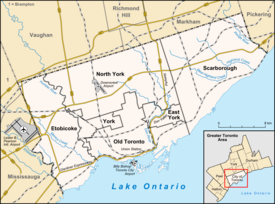Parkwoods
| Parkwoods | |
|---|---|
| Neighbourhood | |
 |
|
| Location within Toronto | |
| Coordinates: 43°45′04″N 79°19′23″W / 43.751°N 79.323°WCoordinates: 43°45′04″N 79°19′23″W / 43.751°N 79.323°W | |
| Country |
|
| Province |
|
| City |
|
| Area | |
| • Total | 4.72 km2 (1.82 sq mi) |
Parkwoods or sometimes referred to as Parkwoods-Donalda, is a neighbourhood in Toronto, Ontario, Canada. It is a geographically large neighbourhood located just south of Ontario Highway 401, West of Victoria Park Avenue, North of Lawrence Avenue East and east of the Don Valley Parkway.
The northern part of the neighbourhood (area north of York Mills Road/Parkwoods Village Drive) is populated by mostly new immigrants to the city and has a mix of lower- and middle-income families. As a result, there is a large number of visible minorities (over 50%). Chinese, South Asians and Blacks (African, Caribbean) make up the largest percentage of ancestries in the area, after European Canadians and other mixes. The area south of York Mills Road is a fairly affluent neighbourhood, with a large number of original homeowners (1957 to 1962 purchasers) still occupants (or their heirs).
In the north-west quadrant of the neighbourhood is the area known as Graydon, which is built up on hillside terrains and is home to the Donalda Golf course.
One of the dominant characteristics of the neighbourhood is its winding streets and undulating topography. Several large parks and trails can be found throughout the area. Of particular note is Brookbanks Park; a branch of the Don Valley ravine system. Running throughout the ravine is Deerlick Creek, which is a tributary of the Don River. "For several seasons in the late '80s and early '90s, Dr. Mima Kapches of the Royal Ontario Museum conducted a variety of archaeological digs in some of the backyards that line the Brookbanks Park ravine. During a dig in the fall of 1987 she uncovered a Meadowood-cache blade dating from 1000 BC, making it one of the oldest ever discovered. Continued excavation the following year uncovered a variety of Middle Archaic period artifacts, including a small pebble that displayed a human face in effigy, believed to have been created in 4,700 B.C. making it one of the oldest dated human representations in northeastern North America. From 1988 to 1990, digs in an adjacent backyard revealed a wealth of Early Iroquoian pottery (ca. AD 1000), as well as the remnants of an "open-pit firing event," a site that would have been used in its production. These discoveries have led local archaeologists to hypothesize that the ravine surrounding Deerlick Creek may have once served as a seasonal pottery production and firing campsite."
...
Wikipedia

